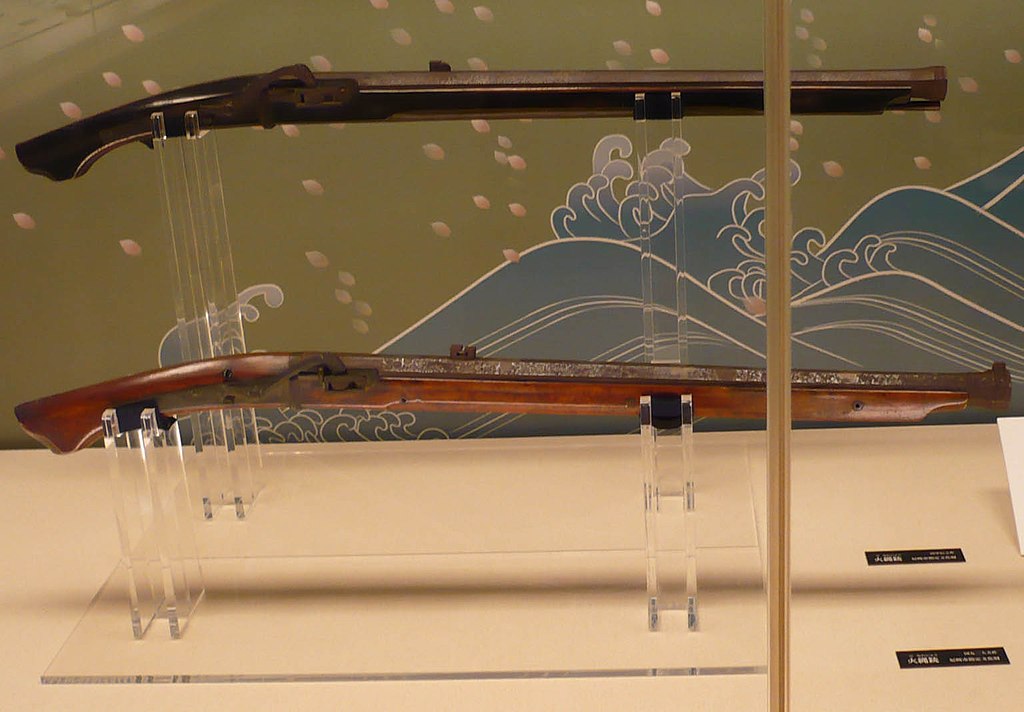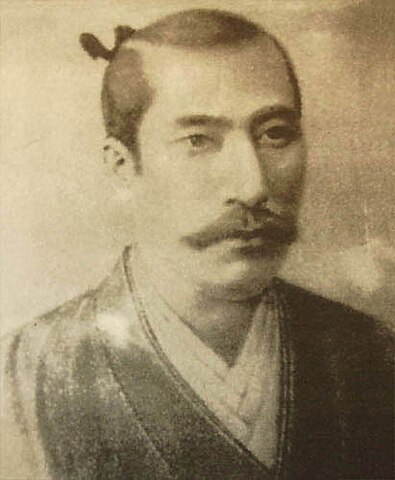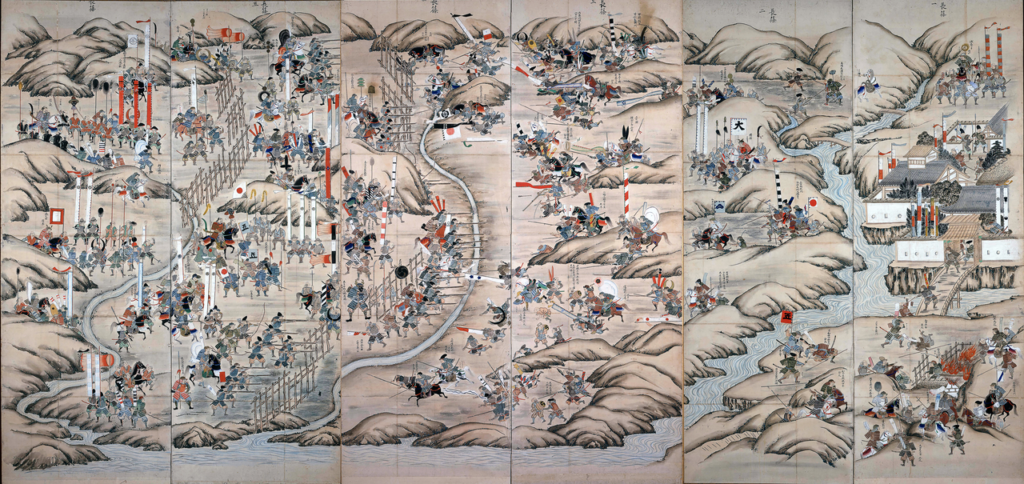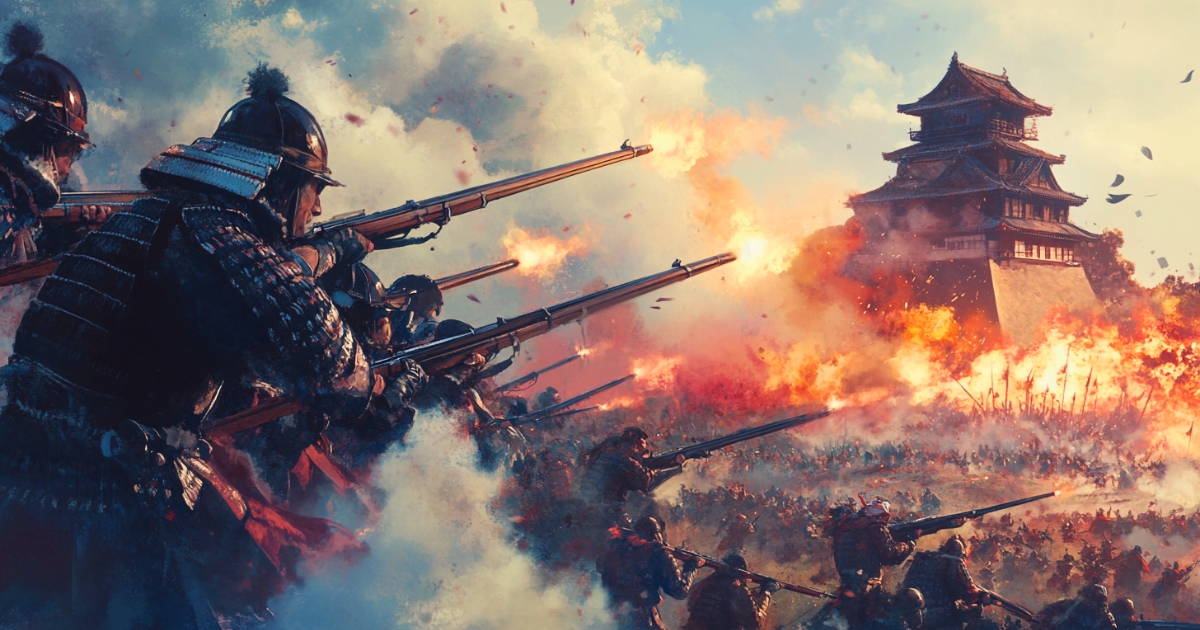In the Sengoku period, a weapon emerged that revolutionized Japanese battlefields: the matchlock gun. Among those who utilized this new technology, Oda Nobunaga’s gun squads stood out for their innovative tactics and overwhelming firepower, dramatically changing the course of the warring states era. This article focuses on Nobunaga’s gun squads, exploring their innovative approach and influence. We’ll delve into the performance and operation of matchlock guns, the training methods and tactics of the gun squads, and examine their use in actual battles, considering the impact Nobunaga’s gun squads had on Japanese military history.
The Arrival and Capabilities of Matchlock Guns

Matchlock guns from the Azuchi-Momoyama to early Edo periods. Their structure and function revolutionized Japanese battlefields. Back: Made by Tanaka Nobuyuki, Front: Made by Kunitomo Santayu. These masterpieces were favored by warlords and marked a turning point in history.
Matchlock guns were introduced to Japan in 1543 by Portuguese castaways on Tanegashima island. While bows and swords were the primary weapons in Japan at the time, the introduction of matchlock guns had the potential to completely change the nature of combat.
The performance of matchlock guns was overwhelming compared to traditional Japanese weapons. While there are various theories about their range, some suggest it exceeded 100 meters. Compared to bows and arrows, they had at least an equivalent, if not superior, range. They also had strong penetrating power, easily piercing through the armor of the time.
However, matchlock guns had their drawbacks. Loading took time, and they were difficult to use in rainy conditions. Accuracy varied greatly depending on the user’s skill level and the conditions of use. Skilled gunners could achieve accuracy comparable to or even surpassing that of archers.
These characteristics of matchlock guns attracted the attention of the warring feudal lords. Among them, Oda Nobunaga was quick to recognize their potential and actively introduced them.
Oda Nobunaga’s Formation of Gun Squads

Portrait of Oda Nobunaga by Giovanni Nicolao. A strategist who saw the potential of gun squads and changed the course of the Sengoku period.
Oda Nobunaga recognized the potential power of matchlock guns and sought effective ways to use them. Nobunaga didn’t just introduce guns; he formed specialized gun squads, a groundbreaking initiative in Japan at the time.
Nobunaga’s gun squad formation had several characteristics:
- Specialization: Gun squad members received specialized training in operating matchlock guns. This improved loading speed and accuracy.
- Mass Adoption: Nobunaga procured as many matchlock guns as possible. It’s said that he deployed 3,000 guns at the Battle of Nagashino in 1575 (though this number is disputed).
- Tactical Innovation: Nobunaga developed new tactics that leveraged the characteristics of gun squads. We’ll look at this in more detail later.
- Continuous Improvement: Nobunaga constantly sought to improve the performance of his gun squads, refining training methods and equipment.
These efforts made Oda Nobunaga’s gun squads one of the most effective military forces in Japan at the time.
Training Methods for Gun Squads
One reason Oda Nobunaga’s gun squads were so powerful was their rigorous training. Nobunaga invested considerable time and effort in improving the skills of his gun squad members.
The training of the gun squads included the following elements:
- Shooting Practice: Repeated target practice to improve accuracy.
- Loading Drills: Thorough practice of each movement to enable quick and reliable loading.
- Group Shooting Drills: Training in coordinated shooting by multiple gun squad members. This led to the later development of the three-volley firing technique.
- Endurance Training: Building physical and mental strength to withstand long battles.
- Weather Adaptation Training: Practicing waterproofing techniques and alternative tactics for use in rainy conditions.
Through these training methods, Oda Nobunaga’s gun squads became elite units capable of flexible tactical operations, not just sources of firepower.
Innovative Tactic: Three-Volley Firing
The main reason Oda Nobunaga’s gun squads were unrivaled by other daimyo was the development of innovative tactics. The most notable of these was the “three-volley firing” technique.
Three-volley firing involved arranging the gun squad in three rows and alternating between shooting and loading. The specific procedure was as follows:
- The first row fires
- The first row steps back and begins reloading
- The second row steps forward and fires
- The second row steps back and begins reloading
- The third row steps forward and fires
- The third row steps back and begins reloading
- By this point, the first row has finished reloading and is ready to fire again
This tactic allowed the gun squad to maintain continuous fire. It was a groundbreaking method that overcame the main weakness of matchlock guns: their long loading time.
The effect of three-volley firing was tremendous. By continuously showering the enemy with firepower, it exerted psychological pressure while preventing the enemy from approaching. This tactic also enhanced the defensive capabilities of the gun squad. The rows not firing acted as shields, protecting the firing squad members from enemy arrows and bullets.
However, some historians have raised doubts about the actual existence of the “three-volley firing” technique. There is little direct historical evidence of this tactic being used, and some researchers question whether such a complex tactic was feasible given the performance of matchlock guns at the time.
While “three-volley firing” is widely known as a symbol of Oda Nobunaga’s innovative tactics, further research is needed on its actual use on the battlefield. However, even if “three-volley firing” itself may not be historical fact, there’s no doubt that Oda Nobunaga pursued effective ways to use gun squads and revolutionized traditional tactics.
The Battle of Nagashino: Proving the Worth of Gun Squads
Oda Nobunaga’s gun squads proved their worth in the Battle of Nagashino in 1575. In this battle, Nobunaga faced off against the Takeda army led by Takeda Katsuyori.
Nobunaga is said to have deployed a large-scale gun squad with 3,000 matchlock guns (though this number is disputed). Furthermore, he set up barricades in front of the gun squad to prevent the Takeda cavalry from charging.

The Battle of Nagashino depicted on the Nagashino Battle Screen. It shows the gun squad firing at the Takeda cavalry.
As the battle began, the elite Takeda cavalry launched a fierce charge. Nobunaga’s gun squad employed the three-volley firing tactic, maintaining constant fire. The mounted warriors were shot down one after another, and the cavalry, trapped before the barricades, became perfect targets for the gun squad.
However, the gun squad wasn’t the only reason for the Takeda army’s defeat. The multi-directional attack by the Oda-Tokugawa allied forces and geographical factors also played significant roles. The Takeda army was surrounded in a narrow valley and couldn’t fully utilize its mobility.
As a result, the Takeda army suffered a crushing defeat, and the myth of the invincible Takeda cavalry was shattered. This battle vividly demonstrated the effectiveness of gun squads and marked a turning point that would greatly change the nature of warfare in Japan.
The Impact of Nobunaga’s Gun Squads on Japanese Military History
Oda Nobunaga’s gun squads had a profound impact on Japanese military history:
- Tactical Revolution: New tactics, exemplified by three-volley firing, were adopted by other daimyo, fundamentally changing the way battles were fought.
- Changes in Military Organization: The existence of specialized gun squads influenced how armies were organized.
- Changes in Castle Structure: To counter guns, castle structures changed. Stone walls became higher, and gun ports were added.
- Changes in the Role of Samurai: Organized combat became more important than individual martial prowess.
- Advancement of Military Technology: The improvement of matchlock guns and the development of related technologies were promoted.
- Impact on International Relations: The mass production and export of guns also influenced Japan’s foreign relations.
These changes had a significant impact not only on military aspects but on society as a whole. The spread of guns became one of the factors leading to the end of the Sengoku period and the formation of a unified state.
Conclusion
Oda Nobunaga’s gun squads did more than just introduce a new weapon; they revolutionized the nature of warfare itself. By maximizing the potential of matchlock guns and using them strategically, Nobunaga significantly altered the military balance of the Sengoku period.
The success of Nobunaga’s gun squads demonstrates the importance not only of introducing new technology but also of creating organizations and developing tactics to use it effectively. This lesson has relevance for modern business and technological innovation.
Oda Nobunaga’s gun squads brought about a revolution in Japanese military history. Their influence extended to the end of the Sengoku period and the dawn of early modern Japan. As an example of how a single technology can greatly change the course of history, Oda Nobunaga’s gun squads continue to offer many insights even today.


